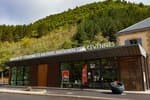La Roque Magnanerie (silkworm farm)
6 points of interest
 Fauna
FaunaSounds in the grass
Have you noticed that meadows are a unique environment? You hear them before you see them. You can guess a meadow is nearby by the chirping and repetitive calls, which combine to create a heady concert.
There are no vocal chords here, but only legs, wings and elytrons being rubbed again and again. Would you be able to imitate the throbbing sound made by crickets rubbing their legs on the edge of their wings ?
How would you know the biodiversity of a meadow if its inhabitants were silent ? Fauna
FaunaOpen your eyes !
Among the chestnut trees, animals keep silent. Only the tiniest of traces allow us to spot them while they are at work. There is nothing flamboyant in their appearance: they are often small, dark and even rather ugly, but their discretion means that they are left in peace to pierce, lay eggs and nibble. You need very good hearing, like the great spotted woodpecker, to hear insects nibbling wood. Holes in tree trunks hint at the presence of the insect-eating woodpecker. Small owls, tits and nuthatches nest in the abandoned holes. Fauna
FaunaIn shade or light
Paths made by wild animals, tracks opened up by humans. Without these openings to let in light, these breathing spaces between trees, how could any animal leave its clearing? Many dislike too much shade: lizards scuttling over hot rocks; praying mantises with their short and slow flight; large dragonflies and butterflies, etc. The stag beetle stays on the edge of the forest, flying heavily from tree to tree. Others, such as arachnids or small mammals, also like these treeless corridors, where they find food in abundance. History
HistoryThe farm with 60,000 worms
Such a big building just for silkworm larvae? It is hard to imagine the not-so-distant past when the silk thread made from the worms’ cocoons was a miracle crop for the region. Farmers planted mulberry trees (whose leaves are all that the silkworm eats) and built odd-looking farms to raise these silkworms, which were so voraciously hungry that they were called manhan (eater), and so fragile that magnaneries had to be provided with numerous windows and chimneys to ensure their wellbeing. Natural environment
Natural environmentIf trees could talk
The fate of some insects and plants is linked to humans, who see them as precious helpers: the bee for its honey; the hummingbird hawk-moth, whose long proboscis enables it to pollinate lavender and sage with their deep flowers; the marmalade hoverfly whose larvae eat aphids... Mulberry leaves were once used to feed silkworms. Some mulberry trees have survived and retain their stocky silhouette and a trunk. Don’t get any closer; watch from afar. It would be a shame to disturb insects at work. Natural environment
Natural environmentBusy nights
Night-time is for animals, whose sharpened senses easily handle the dark that makes us so clumsy. This is the time when genets, martens, foxes and tawny owls set out to hunt. Dormice and wild boar can rummage at leisure looking for acorns, seeds and other roots. Moths take over from their diurnal cousins to fill up on flower nectar – if they manage to escape barbastelles and other bats. The night is an endless feast !
Description
- Departure : Parking spaces at the Magnanerie on the D983
- Arrival : Parking spaces at the Magnanerie on the D983
- Towns crossed : Molezon
Forecast
Altimetric profile
Recommandations
Information desks
Tourism'house and national Parc at Florac
Place de l'ancienne gare, N106, 48400 Florac-trois-rivières
This office is part of the National Park's associated tourist-information network, whose mission is to provide information on, and raise awareness of, the sites and events as well as the rules that must be observed in the National Park's central zone.
On site: exhibitions, video projections, events and shop Open year-round
Tourism office Des Cévennes au mont-Lozère, Sainte-Croix-Vallée-Française
Mairie, 48110 Sainte-Croix-Vallée-Française
This office is part of the National Park's associated tourist-information network, whose mission is to provide information on, and raise awareness of, the sites and events as well as the rules that must be observed in the National Park's central zone. :
Open year-round
Access and parking
Parking :
Source

Report a problem or an error
If you have found an error on this page or if you have noticed any problems during your hike, please report them to us here:


